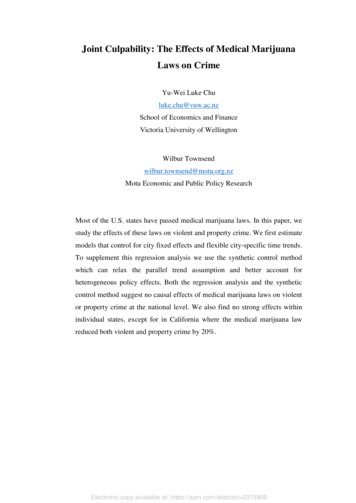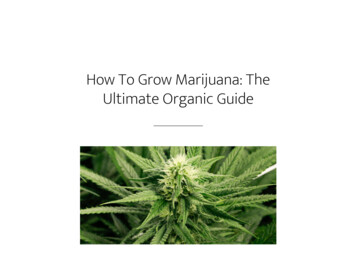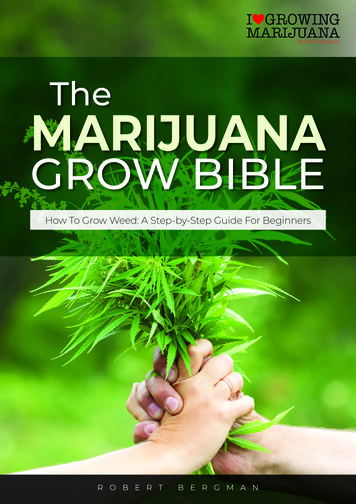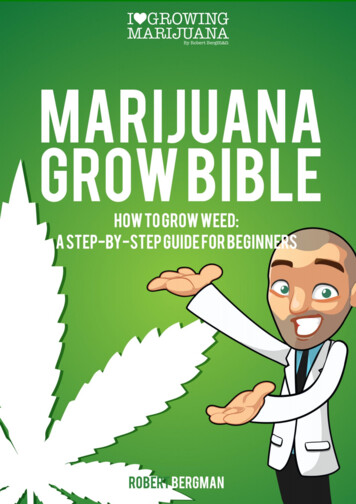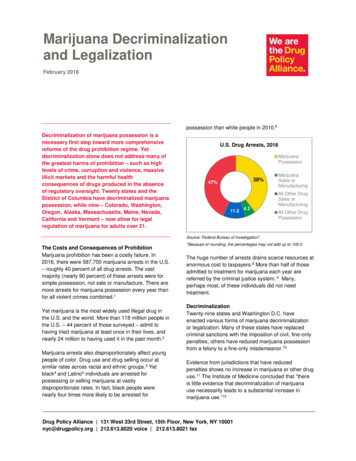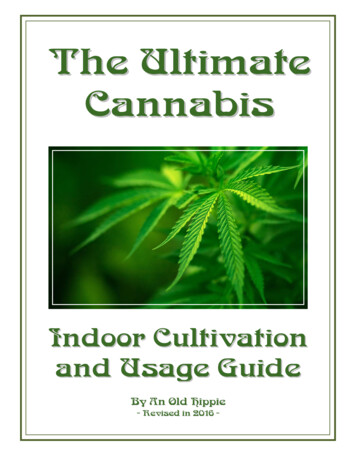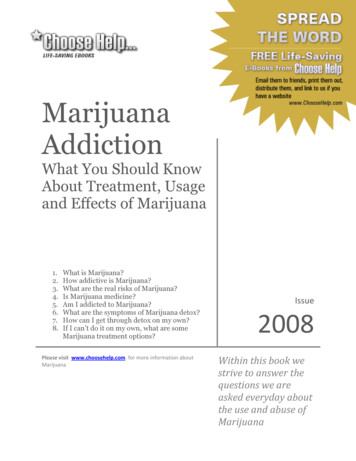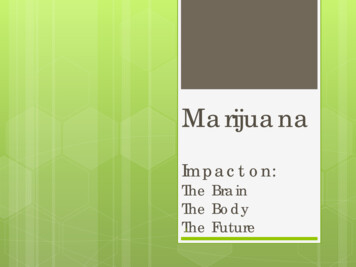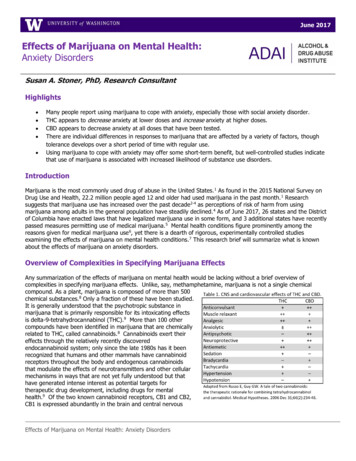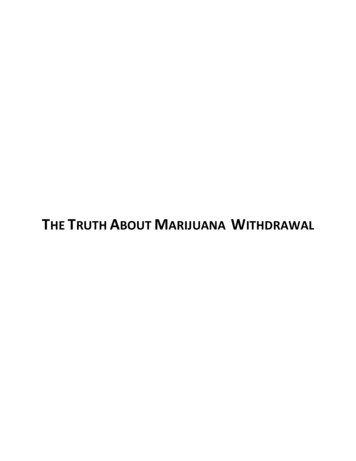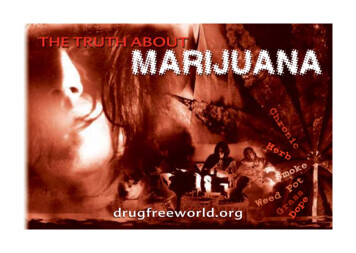
Transcription
THE TRUTH ABOUTMARIJUANAdrugfreeworld.org
WHY THIS BOOKLETWAS PRODUCEDYou hear a lot of talk about drugs thesedays—at school, in the streets, on theInternet and TV. Some of it is true, some not.What you may not know is that much of whatyou hear about drugs actually comes fromthose selling them. Former drug dealers havesaid they would tell people anything to getthem to buy drugs.You need the real facts and the truth aboutdrugs so you can make an informed decisionabout them. That is why we have prepared thisbooklet—for you.Your feedback is important to us, so let usknow what you think about this booklet. Visitus on the web at drugfreeworld.org ande-mail us at info@drugfreeworld.org.2
What is marijuana?Marijuana is one of the most abuseddrugs in the world. There is an evergrowing gap between the latest science aboutmarijuana and the myths surrounding it.Some people think that since it is legal in someplaces, it must be safe. But your body doesn’tknow a legal drug from an illegal drug. It onlyknows the effect the drug creates once youhave taken it. The purpose of this booklet is toclear up some of the misunderstandingsabout pot.Marijuana comes from the Indian hemp plant,and the part that contains the “drug” is foundprimarily in the flowers (commonly called the“buds”) and much less in the seeds, leaves,and stems of the plant.Marijuana, when sold, is a mixture of dried outleaves, stems, flowers and seeds of the hempplant. It is usually green, brown or gray in color.Hashish is tan, brown or blackresin that is dried andpressed into bars,sticks or balls. Whensmoked, bothmarijuana andhashish give offa distinctive,sweet odor.3
There are over 400 chemicals in marijuanaand hashish.(1) The chemical that causesintoxication or the “high” in users is calledTHC (short for tetrahydrocannabinol). THCcreates the mind-altering effects that classifiesmarijuana as a “drug.”Plants, like animals, have traits that protectthem in the wild. Plants can have colorsor patterns that camouflage them frompredators, or they can contain poisons ortoxins that, when eaten, make animals sickor alter their mental capacity, putting themat risk in the wild. THC is the protectivemechanism of the marijuana plant.Intoxication literally means “to poison bytaking a toxic substance into your body.” Anysubstance that intoxicates causes changesin the body and the mind. It can createaddiction or dependence, causing a person towant to take that drug even if it harms himor her.You may have heard someone say thatbecause marijuana is a plant, it’s “natural”and so it’s harmless. But it’s not. Hemlock, apoisonous plant, is also “natural,” but it can kill.The other thing to know is that burning driedleaves and buds and inhaling the smoke into
your lungs is definitely not “natural” and likesmoking cigarettes, can be harmful to your body.As for the medical uses of marijuana, itcontains another chemical called CBD (shortfor cannibidiol). This is the substance mostoften associated with creating medical benefits.Unlike THC, CBD does not cause a high.(2) Itsmedical benefits are still being studied, as aremethods to breed marijuana plants with highCBD and low THC for medical use.Marijuana is a drug like alcohol, cocaine, orecstasy. And like these other drugs, it has sideeffects that can be harmful.5
How is it used?Marijuana can be smoked as a cigarette(joint), but may also be smoked in a drypipe or a water pipe known as a “bong.” It canalso be mixed with food and eaten or brewedas tea. These are called “edibles” and arecovered in detail later in this booklet. Sometimesusers open up cigars and remove the tobacco,replacing it with pot—called a “blunt.” Jointsand blunts are sometimes laced with other,more powerful drugs, such as crack cocaine orPCP (phencyclidine, a powerfulhallucinogen).Marijuana is amixture of dried-outleaves, stems, flowersand seeds of the hempplant. It is usually green,brown or gray in color.Hashish is tan, brown or black resinthat is dried and pressed into bars,sticks or balls. When smoked, bothmarijuana and hashish give off adistinctive, sweet odor.When a person inhalesthe smoke from a joint ora pipe, he usually feels itseffect within minutes. Theimmediate sensations—increased heart rate,lessened coordination andbalance, and a “dreamy,”
unreal state of mind—peak within the first 30minutes.(3) These short term effects usually wearoff in two to three hours, but they could lastlonger, depending on how much the user takes,the potency of THC and the presence of otherdrugs added into the mix.As the typical user inhales more smoke and holdsit longer than he would with a cigarette, a jointcreates a severe impact on the lungs. Aside fromthe discomfort that goes with sore throats andchest colds, it has been found that smoking onejoint gives as much exposure to cancer-producingchemicals as smoking four to five cigarettes.(4)The mental consequences of marijuana useare equally severe. Marijuana smokers havepoorer memories and mental aptitude thando non-users.(5)Recent studies on young adults that smokemarijuana, found abnormalities in thebrain related to emotion, motivation anddecision-making.(6)
DABBINGTHC extracted into an oil can beevaporated into a sticky goo or wax thatis smoked or, more popularly, vaporized.That goo can be further refined into a hardglass-like substance often called “shatter.”This concentrated form of marijuanais heated quickly on a very hot surface,vaporized, and then inhaled through a specialapparatus, sometimes called a “dab rig” oran “oil rig.” This process is called dabbing.8THE EFFECTS OF DABBINGWhen a person inhales a concentrated“hit” through dabbing, the physicaland mental effects that happen with smokingmarijuana are intensified.The THC content in dabs ranges from 60% toas high as 90%.(7)Marijuana concentrates are so new on thescene that their harmful effects have not
been studied. However, doctorsand drug abuse specialists areobserving that the harmfulmental effects created in regularmarijuana are magnified inmarijuana concentrates.Users have reported that this formof marijuana can create psychoticbreaks, hallucinations (seeing andhearing things that are not there), andhaving sensations like insects crawling underthe skin.(8)Because these concentrates are very strong,there have been repeated occasions when911 teams had to be called due to cannabisoverdoses.
up in theIendedmental hospitalMOOKINGbecause it had been 10days and I had gotten10 to 15 hours of sleeptotal.”Smoking tobacco and marijuanatogether in the bowl of a pipe isknown as mooking.The chemicals of tobacco and marijuanawork on the nervous system and affectboth the mind and the body. Some of theseeffects cannot be reversed.(9) Smoking hasbeen known to cause end-stage lung diseaserequiring oxygen tubes 24 hours a day. Whenthis occurs, a person is no longer able tocarry out normal activity. Simple thingslike walking from the bedroom to thebathroom are nearly impossible dueto severe shortness of breath.(9)10
EDIBLESMarijuana or hash oil can be mixed withfood or beverages commonly called“edibles.” Brownies, cookies, candy, sodasand tea are some of the popular forms.When a person smokes marijuana, he feelsthe effects immediately. When a person eatsor drinks marijuana mixed food or drinks,it may take 30 to 45 minutes to digest, sothe length of time for the drug to becomeactivated is longer. In other words, the persondoesn’t feel the effects immediately. Becauseof this, people often eat more. When theeffects finally hit, the chances of becomingextremely intoxicated and even having apsychotic episode are greatly increased.The amount of marijuana in edibles can varywidely, and the amount of THC can be sogreat, people have reported extremeparanoia and anxiety bordering onpsychotic behavior as a result.Here are just a few notable cases involvingedibles: A reporter for The New YorkTimes ate a marijuana-infused candybar and spent eight hours curled up in a“hallucinatory state.” (10) A Coloradoteen ate one serving of a marijuanainfused cookie—1/6 of a cookie.After 30 to 60 minutes hedidn’t feel anything, so heate the rest of the cookie.After the effects ofthe drugs kickedin, he jumped off a4th floor balconyand died fromthe fall. (11)11
VAPINGVaping marijuana is done by placing rawcannabis or THC oil in a vaporizer ore-cigarette. While there are claims that this isa “healthier” way to consume marijuana, theeffects of vaporizers and e-cigarettes have notbeen fully researched in large-scale studies.12
street namesMARIJUANAPotHerbWeedBudsBlazeGrassWhite WidowGanjaDry HighAstro YurfBhangDaggaDopeHempHome GrownJMary JaneReeferRoachPuffTexas TeaHASHISHChocolateHashShitTERMS FOR THE AMOUNTLid: an ounce or lessMatchbox: a small amount that usually comesin a cardboard matchboxNickel bag: a small bag that sells for 5Dime bag: a small bag that sells for 10Quarter: a quarter ounceBrick: 2.2 pounds or one kilogram of tightlycompacted marajuana(12)13
how Marijuana haschanged over timehe Indian hemp plant (from whichcannabis drugs like marijuana andhashish are made) was grown for use asa hallucinogen more than 2,000 years ago.TThe amount of THC in the hemp plantdetermines the strength of the drug. Theamount of THC found in marijuana isnot consistent, and the level of THC hasincreased steadily.By using modern techniques, hemp growershave developed types of cannabis that havemuch higher levels of THC than in the past.The average strength of the marijuanaplant in the U.S. today is around 15–20%.14The highest level found in the plant isaround 32%. (12)For comparison: The pot smoked at Woodstock in1969 and through the late 1970scontained roughly 1% THC. (13) In 1980, it was about 1%. By1997, the average THC contentwas close to 5.1%; in 2008,10.2%. (14)
20%Increase of THC inmarijuana over timeThe more THC, the more psychoactive thedrug and the higher the potential for abuse,addiction, and other harmful 2000200520102015
ALCOHOL VS.MARIJUANAIs smokinga jointthe sameas drinkingalcohol?You decide. Hereare the facts:Alcohol consists ofone substance only: ethanol.Marijuana contains more than 400known chemicals, including the samecancer-causing substances found in tobaccosmoke. Unlike cigarette smokers, pot smokerstend to inhale deeply and hold the smoke as16long as possible to increase the effect of thedrug, worsening the damage to the lungs.Alcohol is eliminated from the body in a fewhours, but THC stays in the body for weeks,possibly months, depending on the length andintensity of usage.THC damages the immune system. Alcoholdoes not.There is no intention here to minimize thedangers of alcohol abuse, which can beequally harmful. Users, however, need to beaware that the chemicals in marijuana, someof them cancer-causing, remain in the bodylong after the drug is taken.
IS MARIJUANAMEDICINE?Components of the marijuana plant mayhave medicinal properties. That is not thesame as “medicine.” Medicine is made when alaboratory extracts the medicinal compound,standardizes it (meaning that it will do the samething every time), and doses it (a standardizedamount the doctor prescribes).The term “medical marijuana” is often appliedto the whole unprocessed marijuana plant orits crude extracts, which are not recognized orapproved as medicine by the U.S. Food and DrugAdministration for any illness.(16)Because marijuana is sometimesmarketed as a medicine, perceptionof the drug has changed. But thebasic facts about marijuana haven’tchanged just because it’s marketedas a “medicine.” And while the debateover legalization presses on, legaldoes not equal safe. Cigarettes arelegal but there is no debate aboutthe fact that smoking is a healthrisk. Alcohol is legal but look at thenumber of people battling alcoholaddiction or illnesses associated withalcohol abuse.17
MARIJUANAAFFECTS DRIVING:he use of marijuanasignificantly impairsjudgment, coordination andreaction time—all skills neededto drive safely. Marijuana isthe second most commonlypsychoactive substance foundamong drivers after alcohol.(17)T18Marijuana users are 3 to 7 timesmore likely to have a car crash.(17)Driving under the influence ofcannabis is associated with a 92%increased risk of vehicular crashes.Important is the fact that suchdriving was associated with a110% increase in fatal crashes.(18)
AAA reported that in the U.S.cannabis-involved fatalitiesincreased from 8% in 2013 to17% in 2014.(19) In Colorado, marijuana useincreased significantly startingin 2009, and a study found thatthe proportion of drivers in fatalcar crashes in Colorado testingpositive for marijuana had risenfrom 5.9% in 2009 to 10% in2011.(20) In the state of Washington,fatal driving accidents have risen122% between 2010 and 2014.(21) In California, the percentageof drivers testing positive formarijuana that were involved infatal car crashes rose from 9% in2005 to 16.5% in 2014.(21)19
THE harmfulEFFECTS OF MARIJUANATsuffer from bronchitis, an inflammation of therespiratory tract.(25)But the problem does not end there. Accordingto scientific studies, the active ingredient incannabis, THC, remains in the body for weeks oreven months.(23)The drug can affect more than your physicalhealth. Studies in Australia in 2008 linkedyears of heavy marijuana use to brainabnormalities.(26) This is backed up by earlierresearch on the long-term effects of marijuana,which indicate changes in the brain similar tothose caused by long-term abuse of other majordrugs. And a number of studies have shown aconnection between continued marijuana useand psychosis.(27)he immediate effects of taking marijuanainclude rapid heart beat, disorientation,lack of physical coordination, often followedby depression or sleepiness. Some users sufferpanic attacks or anxiety.(22)Marijuana smoke contains 50% to 70%more cancer-causing substances thantobacco smoke.(24) One major research studyreported that a single cannabis joint couldcause as much damage to the lungs as upto five regular cigarettes smoked one afteranother.(4) Long-time joint smokers oftenMarijuana canchange the structureof sperm cells,deforming them.
Thus even small amounts of marijuanacan cause temporary sterility in men.(28)Marijuana use can also disrupt a woman’smenstrual cycle.(29)Studies show that the mental functionsof people who have smoked a lot ofmarijuana tend to be diminished. The THCin cannabis disrupts nerve cells in the brain,affecting memory.(30)Cannabis is one of the few drugs that causesabnormal cell division, which leads to severehereditary defects. A pregnant woman whoregularly smokes marijuana or hashish maygive birth prematurely to an undersized,underweight baby. Over the last 10 yearsmany children ofmarijuana usershave been bornwith reducedinitiativeand lessenedabilities toconcentrateand pursuelife goals.(31)Studies also suggestthat prenatal (beforebirth) use of the drug may result in birthdefects, mental abnormalities and increasedrisk of leukemia (cancer of the bone marrow)in children.(31)21
SHORT-TERM EFFECTSLONG-TERM EFFECTS Short-term memory problems Decline in IQ (up to 8 points if prolongeduse started in adolescent age) Severe anxiety, including fear that one isbeing watched or followed (paranoia) Poor school performance and higherchance of dropping out Very strange behavior, seeing, hearingor smelling things that aren’t there,not being able to tell imagination fromreality (psychosis) Panic Hallucinations Loss of sense of personal identity Lowered reaction time Increased heart rate (risk ofheart attack) Increased risk of stroke Problems with coordination(impairing safe driving or playing sports) Sexual problems (for males) Impaired thinking and ability to learnand perform complex tasks Lower life satisfaction Addiction (about 9% of adults and17% of people who started smoking asteens) Potential development of opiate abuse Relationship problems, intimatepartner violence Antisocial behavior including stealingmoney or lying Financial difficulties Increased welfare dependence Up to seven times more likely to contract Greater chances of being unemployedsexually transmitted infections thanor not getting good jobs.(33)non-users (for females) (22,32 & 33)22
using on a dare from a best friendIstartedwho said that I was too chicken to smoke ajoint and drink a quart of beer. I was fourteenat that time. After seven years of using anddrinking I found myself at the end of theroad with addiction. I was no longer using tofeel euphoria, I was just using to feel somesemblance of normality.“Then I started having negative feelingsabout myself and my own abilities. I hatedthe paranoia [suspicion, distrust or fearof other people]. I hated looking over myshoulder all the time. I really hated nottrusting my friends. I became so paranoidthat I successfully drove everyone away andfound myself in the terrible place no onewants to be in—I was alone. I’d wake up inthe morning and start using and keep usingthroughout the day.” —Paul23
ON THEROAD TODRUG ABUSEArecreational user takes marijuana forthe effect it creates and the high orbuzz they want to get from it. Continueduse builds up tolerance and can lead users toconsume stronger drugs to achieve the samehigh. When the effects start to wear off, theperson may turn to more potent drugs torid himself of the unwanted conditions thatcaused him to take marijuana in the firstplace. Marijuana itself does not lead theperson to the other drugs.24People take drugs to get rid of unwantedsituations or feelings. Marijuana masksthe problem for a time (while the user ishigh). When the “high” fades, the problem,unwanted condition or situation returnsmore intensely than before. The user maythen turn to stronger drugs since marijuanano longer “works.”There is also the fact that marijuana userscommonly group together at parties or just
hang out to share it with others. Then whensomeone adds a new drug to that group, itis part of the group mentality for everyoneto join in with that new and potentiallyaddictive drug.The vast majority of cocaine users (90%)began by first using a drug like marijuana,cigarettes or alcohol. (34) Of course, noteveryone who smokes marijuana andhashish goes on to use harder drugs. Somenever do. Others quit using marijuanaaltogether. But some do. One study foundthat youth (12 to 17 years old) who usemarijuana are 85 times more likely to usecocaine than kids who do not use weed, andthat 60% of the kids who smoke weed beforethe age of 15 move on to cocaine. (35)Iwas given my first joint in theplayground of my school. I’m a heroinaddict now, and I’ve just finished myeighth treatment for drug addiction.”— Christian25
Behindthe smokescreenThe use of marijuana is not only harmful tothe pot smoker himself. He can also becomea risk to society.26Research clearly shows that marijuana has thepotential to cause problems in daily life. A studyof 129 college students found that, among thosewho smoked the drug at least 27 of the 30 daysbefore being surveyed, critical skills related toattention, memory, and learning were seriouslydiminished. A study of postal workers foundthat employees who tested positive formarijuana had 55% more accidents,85% more injuries and a 75% increasein being absent from work.
In Australia, a study found that cannabisintoxication was responsible for 4.3% of driverfatalities.It is almost impossible to grow up in America,or any country, and not be exposed to drugs.Peer pressure to do drugs is high and honestinformation about the dangers of drugs is notalways available.Many people will tell you marijuana is notdangerous. Consider who is telling you that.Are these the same people who are trying tosell you some pot?The teacher in the school I wentto would smoke three or fourjoints a day. He got lots of studentsto start smoking, me included. Hisdealer then pushed me to start usingheroin, which I did without resisting.By that time, it was as if my conscience wasalready dead.” — Veronique27
Marijuana can harm a person’smemory—and this impact can last fordays or weeks after the immediate effectsof the drug wear off. In one study, a groupof heavy marijuana users was asked torecall words from a list. Their abilityto correctly remember the words didnot return to normal until as longas four weeks after they stoppedsmoking.(39)Students who use marijuana have lowergrades and are less likely to get into collegethan non-smokers. They simply do nothave the same abilities to remember andorganize information compared to thosewho do not use these substances.28
what dealerswill tell youWhen teens were surveyed to find outwhy they started using drugs in thefirst place, 55% replied that it was dueto pressure from their friends. Theywanted to be cool and popular. Dealersknow this.They will approach you as a friend andoffer to “help you out” with “somethingto bring you up.” The drug will “help youfit in” or “make you cool.”get you to buy their drugs. They willtell you that “weed won’t lead you toharder drugs.”They don’t care if the drugs ruin yourlife as long as they are getting paid.All they care about is money. Formerdealers have admitted they saw theirbuyers as “pawns in a chess game.”Get the facts about drugs. Make yourown decisions.Drug dealers, motivated by theprofits they make, will say anything to29
The Truth About DrugsDrugs are essentially poisons. The amount takendetermines the effect.A small amount acts as a stimulant (speeds youup). A greater amount acts as a sedative (slows youdown). An even larger amount poisons and can kill.This is true of any drug. Only the amount needed toachieve the effect differs.But many drugs have another liability: theydirectly affect the mind. They can distort the user’sperception of what is happening around him orher. As a result, the person’s actions may be odd,irrational, inappropriate, and even destructive.30Drugs block off all sensations, the desirable oneswith the unwanted. So, while providing short-termhelp in the relief of pain, they also wipe out abilityand alertness and muddy one’s thinking.Medicines are drugs that are intended to speed upor slow down or change something about the wayyour body is working, to try to make it work better.Sometimes they are necessary. But they are stilldrugs: they act as stimulants or sedatives, and toomuch can kill you. So if you do not use medicinesas they are supposed to be used, they can be asdangerous as illegal drugs.
WHY DO PEOPLE TAKE DRUGS?REFERENCESPeople take drugs because they want to changesomething in their lives.For the numbered references in thisbooklet, please contact the Foundation fora Drug-Free World.Here are some of the reasons young people havegiven for taking drugs:PHOTO CREDITS: Page 20, 22: Alamy. To fit in To seem grown up To escape or relax To rebel To relieve boredom To experimentThey think drugs are a solution. But eventually,the drugs become the problem.Difficult as it may be to face one’s problems, theconsequences of drug use are always worse thanthe problem one is trying to solve with them.The real answer is to get the facts and not totake drugs in the first place.The real answer is to get the facts andnot to take drugs in the first place.Millions of copies of booklets such as thishave been distributed to people aroundthe world in 22 languages. As new drugs appearon the streets and more information about theireffects becomes known, existing booklets areupdated and new ones created.The booklets are published by the Foundationfor a Drug-Free World, a nonprofit public benefitorganization headquartered in Los Angeles,California.The Foundation provides educational materials,advice and coordination for its internationaldrug prevention network. It works with youth,parents, educators, volunteer organizations andgovernment agencies—anyone with an interestin helping people lead lives free from drug abuse.31
FACTS YOU NEED TO KNOWThis booklet is one in a series of publications that cover the facts about marijuana, alcohol,synthetic drugs, Ecstasy, cocaine, crack cocaine, crystal meth and methamphetamine,inhalants, heroin, LSD and prescription drug abuse. Armed with this information, thereader can make the decision to live a drug-free life.For more information or to obtain more copiesof this or other booklets in this series, contact:Foundation for a Drug-Free World1626 N. Wilcox Avenue, #1297Los Angeles, CA 90028 USATMdrugfreeworld.org e-mail: info@drugfreeworld.orgPhone: 1-888 NO TO DRUGS (1-888-668-6378) 2016 Foundation for a Drug-Free World. All Rights Reserved. The Foundation logo is a trademark owned by theFoundation for a Drug-Free World. #S000185
EDIBLES 12 Vaping marijuana is done by placing raw cannabis or THC oil in a vaporizer or e-cigarette. While there are claims that this is a "healthier" way to consume marijuana, the effects of vaporizers and e-cigarettes have not been fully researched in large-scale studies. VAPING 13 street names TERMS FOR THE AMOUNT

